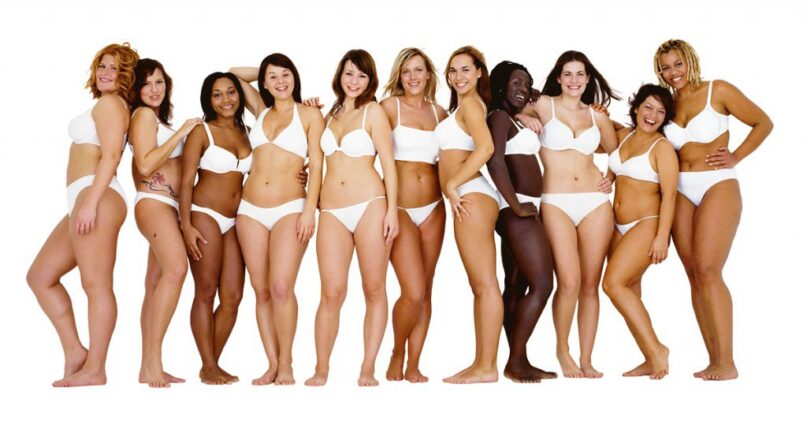Is There an Ideal Body?
Nothing like paging through a fashion or woman’s magazine to feel depressed or dissatisfied with one’s own body size and look. According to the hundreds of images that we see daily on social media, TV, and ads, the “ideal” woman for 2017 is thin, with obvious muscles, full breasts, and a prominent “booty.” There are now some shifts to the more athletic body type that is slowly infiltrating media sources. Intellectually, we know that these proportions are nearly impossible to find in real life–and that most female images have been altered to remove every flaw, bump, and wrinkle, while muscle definition and more generous curves are also just a key stroke away.
And yet the sheer barrage of distorted images in the media can be overpowering. It may help to know that there is no real “ideal” shape for women (or men). In the last 100 years alone, the look of the ideal woman has changed drastically—even within a decade—based on current events and changes in the culture.
At the turn of the last century, women were just beginning to participate more noticeably in public life, from playing sports to working behind department store counters. The woman’s more visible role in society was reflected in the idealized “Gibson Girl,” created around 1910 by illustrator Charles Dana Gibson. The ideal young woman was tall, with a proud, regal bearing, an elaborate hairdo, and an imposing figure—a large bust, wide hips, a long neck, and a cinched waist.
Short-term Pleasures
But the horrors of WWI smashed these old-fashioned ideals. As men faced death and terrible injuries, the mood of the country became more cynical, with a focus on short-term pleasures. The “flapper” ideal emerged. She celebrated her new freedom to drink, smoke, and enjoy sex before marriage by acting more traditionally “masculine” and actually looking more like a boy. Within just 10 years, the ideal woman was now short, slim, with small hips and a nearly nonexistent bust (many women even taped over their breasts to make them as flat as possible). The waistline had moved to hip level, while hemlines rose to near the knees, and the corset had disappeared. Loose, flowing clothing and cropped hair allowed young women to dance riotously to the new jazz sounds, from the iconic Charleston, to the scandalous “shimmy.” The first Miss America, Margaret Gorman, idealized this look in 1921 with her 5’1 inch, 108-pound frame.
While curves made a small comeback in the 1930s, by the 1940s, the look had changed again. The softer look of the 1930s was replaced by a style that suited women who had to work hard in factories and in home businesses, while men left for war. The ideal woman was now taller, more angular, with broader shoulders that were emphasized by boxy, heavily padded suits. The look was more aggressive—even bras were pointy, with names like “bullet” and “torpedo.”
The Era of the Bombshell
By the 1950s, the soldiers had come home and expected their wives to return to homemaking and seducing their husbands. This was the era of hyper femininity—the voluptuous “bombshell” look—exemplified by Marilyn Monroe, a curvy size 12 with large breasts, a small waist, and shapely legs. Slim young women were even encouraged to take supplements to become more curvy like the sex symbols of the day, from Jayne Mansfield to Sophia Loren and Gina Lollobrigida.
Just as the boyish flapper look marked a change in the role of women and sexual mores in the ‘20s, by the 1960s, the move to greater sexual freedom and the blurring of the sexual roles was exemplified by the androgynous, petite, super thin model, Twiggy. While Twiggy claims her figure is the result of genes and a fast metabolism, her look is blamed for launching the ongoing American obsession with diet to alter one’s body type. It is not surprising that Weight Watchers was founded in 1963 and is still going strong.
By the 1970s, curves started to come back, but to rock tight hip huggers and a halter top also required a slim figure and flat stomach. By the 1980s, thanks to super fitness stars like Jane Fonda, the ideal body was not only lean, but super fit. Muscles became not only acceptable, but desirable. As women also flexed their muscles in the work force, the ideal woman was exemplified by tall, leggy supermodel Amazons—like Elle MacPherson, Naomi Campbell, and Cindy Crawford.
Women Starve and “Disappear”
As culture was reshaped by the force of women in the workforce, equal rights struggles for both women and minorities, and cataclysmic changes in how children are reared when both parents work, it is not surprising that the new ideal woman for the 1990s was the androgynous waif—unathletic, thin to the point of gauntness, petite, childlike and unthreatening in slouchy jeans, oversized, fraying sweaters, and androgynous clothes and fragrances. Exemplified by Kate Moss and stars like Winona Rider, this new ideal required women to practically “disappear” by nearly starving themselves or substituting cigarettes and drugs for food.
By 2000, as men and women become more comfortable with new, more equal relationships, the waif ideal disappears and healthy, fit supermodels like Giselle Bundchen become the norm, with a combination of curves and visible muscle definition. By 2017, the ideal figure perpetuated in the media must have it all. Not only is she super thin; she must have defined muscles, incongruous large breasts spilling out of her pushup bra, with a captivating, and often surgically enhanced, booty. In other words, most women can no more meet the current ideal than to look like the Gibson girl in 1910 or Twiggy in the 1960s. The only solution is to accept that the ideal body is not to be found in the media. With the exception of companies like Dove and H&M that have brought more diverse women and body types into their ads, the barrage of unnatural, unrealistic body images will continue. We must look inward to determine our own ideal—a body that pleases us and allows us the satisfaction of doing the activities we enjoy.






